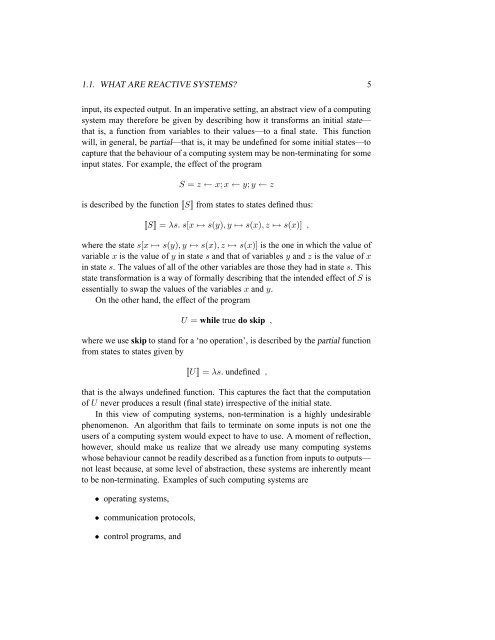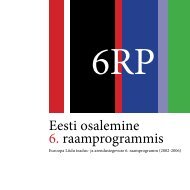Reactive Systems: Modelling, Specification and Verification - Cs.ioc.ee
Reactive Systems: Modelling, Specification and Verification - Cs.ioc.ee
Reactive Systems: Modelling, Specification and Verification - Cs.ioc.ee
Create successful ePaper yourself
Turn your PDF publications into a flip-book with our unique Google optimized e-Paper software.
1.1. WHAT ARE REACTIVE SYSTEMS? 5<br />
input, its expected output. In an imperative setting, an abstract view of a computing<br />
system may therefore be given by describing how it transforms an initial state—<br />
that is, a function from variables to their values—to a final state. This function<br />
will, in general, be partial—that is, it may be undefined for some initial states—to<br />
capture that the behaviour of a computing system may be non-terminating for some<br />
input states. For example, the effect of the program<br />
S = z ← x; x ← y; y ← z<br />
is described by the function [S ] from states to states defined thus:<br />
[S ] = λs. s[x ↦→ s(y), y ↦→ s(x), z ↦→ s(x)] ,<br />
where the state s[x ↦→ s(y), y ↦→ s(x), z ↦→ s(x)] is the one in which the value of<br />
variable x is the value of y in state s <strong>and</strong> that of variables y <strong>and</strong> z is the value of x<br />
in state s. The values of all of the other variables are those they had in state s. This<br />
state transformation is a way of formally describing that the intended effect of S is<br />
essentially to swap the values of the variables x <strong>and</strong> y.<br />
On the other h<strong>and</strong>, the effect of the program<br />
U = while true do skip ,<br />
where we use skip to st<strong>and</strong> for a ‘no operation’, is described by the partial function<br />
from states to states given by<br />
[U ] = λs. undefined ,<br />
that is the always undefined function. This captures the fact that the computation<br />
of U never produces a result (final state) irrespective of the initial state.<br />
In this view of computing systems, non-termination is a highly undesirable<br />
phenomenon. An algorithm that fails to terminate on some inputs is not one the<br />
users of a computing system would expect to have to use. A moment of reflection,<br />
however, should make us realize that we already use many computing systems<br />
whose behaviour cannot be readily described as a function from inputs to outputs—<br />
not least because, at some level of abstraction, these systems are inherently meant<br />
to be non-terminating. Examples of such computing systems are<br />
• operating systems,<br />
• communication protocols,<br />
• control programs, <strong>and</strong>
















